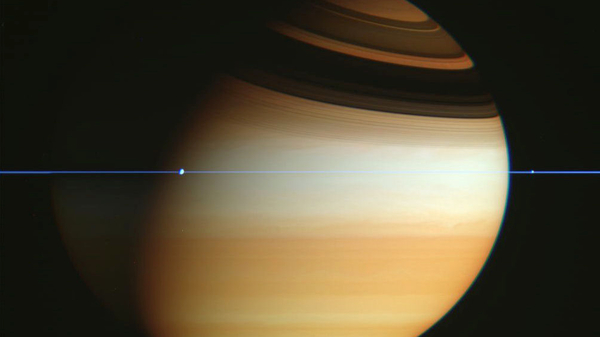Saturn: The Ringed Planet
The rings of Saturn are one of the most exquisite sights in the solar system.

The largest gap within Saturn’s main rings is called the Cassini Division.
©NASA/JPL-Caltech/Space Science Institute
Jupiter and Moon Close Approach 2024
A Brief Overview of Saturn
Saturn is the sixth planet from the center of the solar system. Like Jupiter, Saturn is a gas giant mostly made of hydrogen and helium. It is 84 percent the size of Jupiter in terms of diameter but only 30 percent as big in terms of mass.
Compare the sizes and order of the planets
Saturn’s rings consist mainly of small ice particles. The width of the main rings is about 62,000 kilometers (39,000 miles), but the thickness is a mere 5 to 30 meters (15 to 100 feet).
Where Is Saturn in the Sky?
Find and track Saturn with our Interactive Night Sky Map
Check the weather in your town or city
When Is the Best Time to See Saturn?
Saturn is the farthest away of the naked-eye planets, which humans have been studying since long before the invention of the telescope. It can be seen, at some point or another, on most nights.
At opposition, when it lies directly opposite the Sun, Saturn is visible all night. It rises around sunset and sets around sunrise. At solar conjunction, the planet passes behind the Sun and disappears from view completely for a few weeks.
The time from one Saturn opposition to the next is about 378 days, or just over one year.
A small telescope is needed to see Saturn’s rings. From Earth, the angle of the rings changes from year to year. Every 15 years or so, the rings are edge-on to us and appear super-thin. This coincides with an equinox on Saturn. The next time this happens will be in 2025.
Next opposition: September 8, 2024
Next solar conjunction: March 12, 2025
Previous solar conjunction: February 28, 2024
Previous opposition: August 27, 2023
How far is Saturn from Earth right now?

Saturn’s rings are incredibly thin. This image was made from photos taken by the Cassini spacecraft. The rings are seen edge-on and appear as a thin blue line. The dark bands across the upper half of Saturn are shadows made by the rings. The moons Dione and Enceladus, which orbit Saturn outside the main rings, are also visible.
©NASA, ESA, JPL, ISS, Cassini Imaging Team, Fernando Garcia Navarro
How Long Is a Day and a Year?
Saturn is the second-fastest spinner in the solar system after Jupiter. Its solar day is about ten and a half hours.
A tropical year on Saturn is around 10,747 Earth days, or about 29 Earth years and 5 Earth months.
How Many Moons Does Saturn Have?
Saturn has around 150 known natural satellites, or moons. This is more than Jupiter, which has around 100.
Saturn’s largest natural satellite is called Titan. It is the second-largest moon in the solar system after Jupiter’s Ganymede and the only one to have a thick atmosphere.
Titan is also the only astronomical body—apart from Earth—known to have seas, lakes, and rivers on its surface. These features are made of liquid methane and ethane at extremely cold temperatures (around -179 degrees Celsius, or about -291 degrees Fahrenheit).

An image of Titan taken by the Huygens probe from 2 kilometers (1.2 miles) above the surface. Huygens landed on Saturn’s largest moon on January 14, 2005.
©ESA/NASA/JPL/University of Arizona
Human Exploration of Saturn
In 1610 Galileo became the first astronomer to see Saturn’s rings, although he described them as “ears.” In 1659, as telescopes improved, Christiaan Huygens suggested Saturn had a ring. Huygens also discovered Titan, which became the sixth known moon in the solar system, after our own Moon and the Galilean moons of Jupiter.
More than four centuries later, in 1979, Pioneer 11 became the first spacecraft to make a flyby of Saturn. It was followed by Voyager 1 in 1980 and Voyager 2 in 1981.
The only other spacecraft to visit Saturn is Cassini, which orbited the ringed planet between 2004 and 2017. Cassini carried the Huygens probe, which successfully landed on Titan in 2005—the farthest away that a spacecraft from Earth has attempted a landing.
How Long Does It Take to Get to Saturn?
Spacecraft slow down as they travel away from the Sun. To make it as far as Saturn, they need some help from gravity assist maneuvers, using flybys of other planets to gain extra speed.
Pioneer 11 and the Voyager spacecraft both used a gravitational assist from Jupiter to reach Saturn. However, the alignment of the planets was more favorable for the Voyager spacecraft. Voyager 1 reached Saturn in a little over three years—less than half the time of Pioneer 11.
The Cassini-Huygens mission used four gravitational assists—two from Venus, one from Earth, and one from Jupiter—to reach Saturn in about six and a half years.
Pioneer 11
- Launched: April 6, 1973
- Arrived: September 1, 1979 (flyby, closest approach)
- Journey time: 6 years, 4 months, and 26 days
Voyager 1
- Launched: September 5, 1977
- Arrived: November 12, 1980 (flyby, closest approach)
- Journey time: 3 years, 2 months, and 7 days
Cassini-Huygens
- Launched: October 15, 1997
- Arrived: July 1, 2004 (entered orbit)
- Journey time: 6 years, 8 months, and 16 days
All dates are shown in UTC.